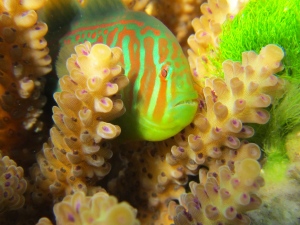We're open daily this holiday! View holiday hours
Science News
Coral Bodyguards
November 13, 2012

What do some corals do when they’re threatened? They call for help, of course!
A species of Pacific coral, Acropora nasuta, grows rapidly and provides much of the structure for reefs, making it important to reef ecosystems. But toxic seaweed can compete with the coral for sunlight and sometimes releases chemicals that may destroy the animal.
Researchers from Georgia Tech discovered that A. nasuta has bodyguards to help protect it from the nasty seaweed: two species of small, colorful gobies.
How do the gobies know the coral is in danger? It’s not the scent of the seaweed itself, scientists Danielle Dixson and Mark Hay discovered, but rather a chemical that the coral releases when it finds itself threatened by the seaweed.
“These little fish would come out and mow the seaweed off so it didn’t touch the coral,” says Hay. “This takes place very rapidly, which means it must be very important to both the coral and the fish. The coral releases a chemical and the fish respond right away.”
The gobies responded so quickly, in fact, that the amount of offending seaweed declined 30 percent over a three-day period, and the amount of damage to the coral declined by 70 to 80 percent.
By studying the contents of the fish digestive systems, the researchers learned that one species of goby—Gobiodon histrio—actually eats the noxious seaweed, while the other fish—Paragobiodon echinocephalus—apparently bites it off without eating it.
So what do the gobies get out of the transaction? A home, food and protection. The inch-long fish spend their entire lives in the crevices of the coral, eating the coral’s mucus as well as algae that live in a symbiotic relationship with the coral. In addition, eating the toxic seaweed gives the gobies toxic properties to ward off predators.
This mutualistic relationship between the fish and the coral is the first known example of one species chemically signaling a consumer species to remove competitors.
“These kinds of positive interactions need to be better understood because they tell us something about the pressures that have gone on through time on these corals,” says Hay. “If they have evolved to signal these gobies when a competitor shows up, then competition has been important throughout evolutionary time.”
The research is published in the current edition of Science.
Image: Danielle Dixson